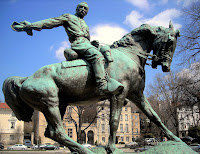Salve,
ancient Athenian writer Thucydides said that there was no nation equal in military prowess to the Scythians/Skithians, and perhaps he was right issuing such opinion, eg the Achaemenid Persians and the Macedonians found this in a hard way.
So the Hellenes could have counted themselves lucky that such bellicose neighbours preferred to stay in their great steppe and not to conquer the rest of the known world.
Back to the Skithians et al., during the long Hellenic colonization of the shores of the Pontic [Black] Sea there sprung many settlements in the Tauris [Crimean] Peninsula, mostly in the southern shores of this peninsula, including Pantikápaion [Panticapaeum] in the Cimmerian Bosporus [Kerch Peninsula], settled by the Milesian (Ionian Milethus- during the 'pre-Persian wars' period the greatest of all Greek cities).
Herodotus, the famed grandfather of history - :) ,wrote plenty about slavery in the north and the role of trade between the north Pontic regions and Hellenes.
Eventually a kingdom, called Bosporan Kingdom, arose in the Tauris and for 3 centuries one dynasty, Spartocids, had ruled the peninsula and its trade routes - slaves, grain, honey, furs etc - with Graecia. Interestingly , in this kingdom the Thracians, Hellenes, and the ancient nomads came together, and the first ruler of the late V century Bosporan Kingdom was a Thracian strongman named Spartocus/Spartokos, hence the Spartocid dynasty.
There had been many contacts between the Athenians and other Greeks and the Skithian world of Black Sea, some happy and many unhappy, i.e. the slave trade.
It has been more or less proved that the famous Athenian orator Demosthenes was of the Skithian descent, namely his maternal grandfather Gylon of Cerameis, who was a warrior and soldier, was a garrison commander in the city of Nymphaion (Nymphaeum) on Cimmerian Bosporus in the late V century. When the city broke its alliance with Athens (for Athens quite like later Rome with Aegyptus used the Pontic grain route to feed its population, and Nymphaion being positioned on the Chersonese sat on that grain route) and allied itself with the Spartocid Kingdom he was accused of treason by the Athenians.
He fled into the Scythian interior and there married a Skythian noblewoman. They had two daughters - Cleobule and Philia - probably while still in the Scythia. Now, Athens had some very prohibitive laws when came to descent, citizenry and full rights of citizenship. Around 451BC Pericles, the good freedom defender no doubt, had the Athenians pass a restriction on the so called 'bastards' (nothoi) that required that both parents had to have been Athenian citizens in order for the kids to have been legitimate and to have possessed the full Athenian citizenship. Between 431 to 404BC the law was suspended - go figure, the Peloponnesian war must have made these restrictions problematic when soldiers were needed.
Back to Gelon, eventually Gelon and his family sailed to Athens, he was fined and paid this fine for his role in Nymphaion debacle, and was able to make his daughters Athenian citizens. Historians speculate that Gelon's unnamed Scythian wife must have been wealthy and the wealth was used to by their way back into Athens and to find husbands among the Athenian well-to-do citizens. Hence well-of Athenian citizen Demosthenes' father (named Demosthenes) married Cleobule and our famous orator was born. Philia married another well-to-do Athenian Demochares. But later on, when Demosthenes was practicing as a layer and was active as a politician he was often called a barbarian and Scythian by his legal and political opponents in Athens, his family lineage being denigrated in public.
Greeks had Scythian archers and slaves in their service - here a nice article on the subject - and hence my quick sketch, it badly needs to be reworked and finished one day, represents such 'policeman,' while a Greek mercenary soldier eyes him with a suspicion.
And if you are looking for some entertainment reading in this area, like a nice long historical fiction, I could point you the first 3 Tyrant cycle/saga novels by Christian Cameron - I truly like them - so a strong thumb up.
The Skithian topics to be continued..
enjoy
















